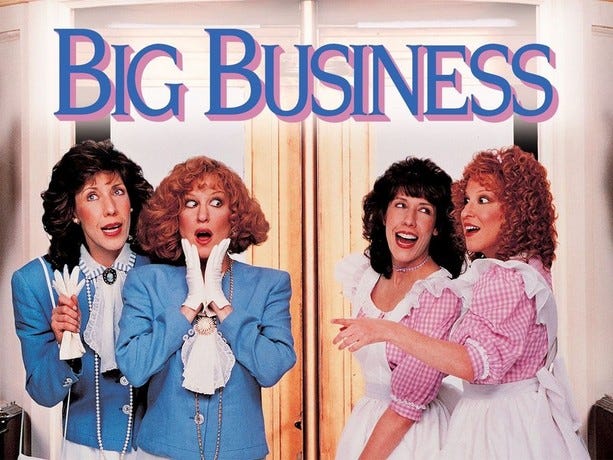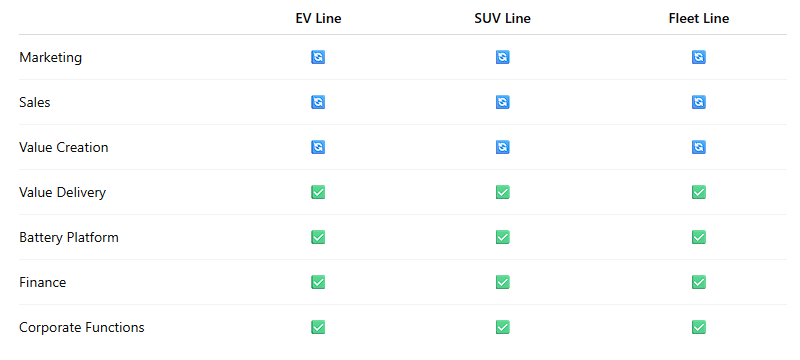Understanding Structures of the Business
A story-led guide to map customers, products, value streams, and functions into an org structure that reliably ships value.
I used to think “value stream” was the North Star. Map the flow of work, optimize it, ship. Then I watched a team design a beautiful stream that serves no one. It wasn’t wrong. It was one-dimensional.
Business isn’t a flat diagram. It’s a layered system. If you architect software without seeing those layers, you end up translating requirements in the dark. Our job is to reflect how the business actually creates, sells, and supports value—then shape software to match that reality.
If we’re clear on the purpose, let’s walk through the other dimensions that give a business its shape. We’ll stay practical and keep a car manufacturer in mind as a running example.
Customer Segments — Who do we serve?
Before you sketch any boxes, ask the only question that cuts across everything else: Who is this for?
Customer segments set expectations for value, buying journeys, and how people interact with your business. They quietly dictate pricing, compliance, onboarding, service-level agreements (SLAs), and support models.
You might serve:
Individual retail buyers
Corporate/fleet customers
Government agencies
Ecosystem partners or vendors
Car manufacturing example:
Individual buyers care about features, price, and brand.
Fleet managers prioritize total cost of ownership, reliability, and logistics.
Governments demand compliance and sustainability.
Even if the product is technically the same, the flow of value changes by segment; ignore this layer, and you risk optimizing for no one.
Product — What do we deliver?
Products are the surface area of value—the thing customers touch. Some companies are product-led, some service-led, and most blend both. Even internal teams have “products,” whether or not they’re sold.
Think of products as the outcome of value, not the structure that creates it.
Car manufacturing example:
EV product: a compact electric model.
Fleet product: a delivery-van bundle with support.
Internal product: battery modules reused across EVs and SUVs.
Use the product lens to manage lifecycle, fit, roadmap, support, and upgrades. But remember: the product is what’s delivered, not how it’s delivered.
Value Streams — How value flows
Now connect the first two dimensions. A value stream forms when you answer: What do we deliver, and to whom?
A value stream is a flow-based unit of value creation and delivery—from trigger to outcome. It can be external (customer-facing) or internal (supporting/enabling). If you know the customer segment and the product, you’re halfway to mapping the stream—then aligning teams, funding, and architecture around it.
Car manufacturing example:
EV Line: delivering compact EVs to end customers.
SUV Line: delivering premium SUVs to dealerships.
Fleet Line: delivering commercial vehicles to business clients.
Internal: a Battery Systems Platform that supports multiple lines.
Value streams are the bridge between who you serve and what you deliver. They make accountability and flow visible.
Functional Dimension — Who does what?
Functions are the business’s horizontal muscles. Just as engineering often organizes by frontend, backend, QA, and infra, the business organizes by broader capabilities:
Marketing creates demand.
Sales convert demand into revenue.
Value Creation builds the product or service (R&D, engineering, production).
Value Delivery/Support gets it to the customer and keeps it working.
Finance manages money, budgets, and compliance.
Corporate Functions (HR, IT, Legal, Risk) support the whole.
Car manufacturing example:
Marketing promotes new models to target segments. Sales manages dealerships and fleet contracts. Value Creation spans R&D, engineering, and production. Value Delivery handles distribution, logistics, and post-sale support. Finance steers pricing, cost control, and profitability. Corporate Functions keep the system healthy.
Functions exist regardless of product or stream. They specialize and scale. They also cut across streams—which is where things can get tricky.
Functions × Value Streams — The organizational matrix
Organizational structure isn’t its own dimension. It’s the outcome of choices at the intersection of functions (rows) and value streams or product lines (columns). Picture a matrix:
The decision in each cell is strategic but straightforward:
Centralize (✅): one shared team serving multiple streams.
Decentralize (🔄): embed the function inside each stream.
Car manufacturing example:
A shared Finance function sets pricing and budgets across all lines.
Value Creation may decentralize, so EVs, SUVs, and Fleet each own engineering and production.
Corporate Functions like HR and IT often centralize.
A note on internal value streams: The Battery Systems Platform doesn’t live as its own vertical. It operates horizontally as part of Value Creation or Value Delivery. It has customers (other teams), governance, and its own flow of work. Architecturally, treat it as a reusable platform—not a one-off tool.
The org chart is simply the implementation of this matrix. It encodes decision rights, funding, ownership, and prioritization.
From market to structure — tying it together
Here’s the practical path to design an organization that mirrors how value really moves:
Start with customer segments. Who are you serving, and how do their needs differ?
For each customer segment, list the top three points of friction in buying, onboarding, or support. That reveals where streams must differ.Define the products. What do you offer that delivers value to those customers?
Write a one-line “product = outcome” statement for each offering (internal included). It keeps the scope honest.Group into value streams. Each meaningful product × customer combination becomes a unit of delivery and accountability.
Follow a single trigger-to-outcome path. Note every handoff and decision point. Align teams and funding to the flow you observe.
Identify internal value streams (e.g., batteries) and define them as reusable platforms with clear customers, governance, and roadmaps.Clarify the functions. What must a business do well to operate effectively? These are your horizontal capabilities.
Put your functions on rows, streams on columns. Circle the cells where centralization creates leverage; star the cells where embedding protects speed.Build the org matrix. Combine streams with functions and choose which to centralize, embed, or platformize as reusable capabilities.
This approach helps you:
Reflect the real flow of value.
Support accountability and reuse.
Balance autonomy with efficiency.
Architecture isn’t about drawing boxes; it’s about structuring decisions, responsibilities, and capabilities to deliver value—reliably and repeatably.
Final thoughts
No single view reveals how a business operates. You need the intersections:
Where value streams cross functional boundaries.
Where org structure blocks—or enables—flow.
Where customer segments pull in different directions.
Where internal products deserve governance, just like external ones.
Make those intersections intentional, not accidental. When we design software to fit the actual shape of the business, translation gets easier, delivery gets faster, and value shows up where it should—right in the hands of the customer.
Want to learn more?
🎓 Check out the course: Modeling, Viewpoints, C4
🌐 Follow us on LinkedIn: Software Architecture Guild
📖 Explore the Free Guide: Jump to Website



